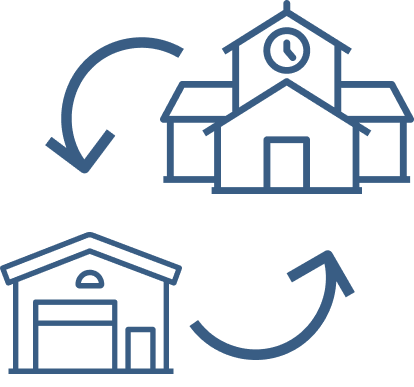Language and communication strategies to support primary aged children with FASD.
Primary School ResourcesThe purpose of this factsheet
This factsheet is designed to assist primary school teaching and support staff to adapt their communication, teaching, and learning strategies to meet the language and communication needs of children with FASD. It’s important to note that each child with FASD is different and will have their own strengths and challenges. These strategies may not be effective every time and maintaining flexibility is crucial when supporting children in their ongoing learning. Additionally, while these strategies are designed to support children with FASD, they may also be useful ways to communicate with all children.
The importance of language and communication
Strong language skills and effective communication are crucial for a young person’s success in the school environment. They underpin learning in all areas and are: (i) the building blocks for basic skills like literacy and numeracy, (ii) crucial to understand class content and express ideas, and (iii) important for behaviour, social skills, friendships, and working with others. There are many different components of language including expressive language (how a child uses words to express themselves), receptive language (the ability to understand words and language), and higher order skills such as advanced vocabulary, understanding word relationships, and paraphrasing. Competency in all language components is crucial for effective social and functional communication. Social communication is communication used in social situations and when interacting with others and functional communication is about communicating information that serves a purpose or meets a need.
Language, communication, and FASD
Language is one of the ten neurodevelopmental domains that can be affected by FASD, and it can be impacted in a variety of ways (CLICK HERE to read our resource that outlines common presentations of FASD in the school environment, including language). Children with FASD may develop language skills at a slower rate than their typically developing peers, and FASD can affect articulation, grammatical ability, vocabulary, and both expressive and receptive language skills. For example, compared to typically developing children, children with FASD may display poorer performance on word ordering, sentence combining and grammatical comprehension. Additionally, their expressive language skills (what they say) tend to exceed their receptive language skills (what they can understand and apply). Consequently, children with FASD are often able to repeat or parrot back what someone has said to them, without understanding the substance or meaning. This, combined with the fact children with FASD are commonly observed to be talkative and engaged, often results in an over-estimation of their language capabilities, which can cause breakdowns in communication between educators and students.
Children with FASD may also display difficulties with communication, such as trouble maintaining conversation, answering questions, and staying on topic. They may also experience challenges producing language that considers the listener’s perspective and have trouble responding appropriately to assumptions about shared knowledge. This impedes communication during social interactions and may lead to misunderstandings and difficulty negotiating peer conflict. The impacts of FASD on social communication are often evident in the classroom or school environment. For example, children with FASD have been found to socially engage less and display more irrelevant (off-task) social behaviour during classroom activities. Teachers, support staff, and parents consistently report concerns about social communication, difficulty interacting with peers, and managing classroom situations.
This table outlines some brief suggestions to help educators adapt their language and communication to better meet the needs of children with FASD. Some additional strategies can also be found in our teaching and learning strategies factsheet. We’ve also explored three strategies in more detail below.
| Strategy | What to avoid or what not to do | What to do |
|---|---|---|
| Use simple clear language. | Avoid complex or unclear language. Don’t use phrases like “class, it’s time to pack up”. | Use direct clear language that states exactly what you mean or want the child to do. For example, say “please put your books away now”. |
| Use positive phrasing. | Avoid saying things like “don’t run”. | Say “please walk”. |
| Avoid using idioms, figures of speech, euphemisms, and sarcasm. | Avoid phrases or words with double meanings. Don’t use phrases like “let’s call it a day” or “cutting corners”. | Use concrete language. For example: “we are finished our classwork for today”. |
| Ask the student to show they understand. | Don’t simply ask a child to verbally repeat an instruction. | Ask the child to demonstrate what you have asked them to do. For example, say “please show me how you will pack your books away”. |
| Give the child time to think before expecting a reply or instructions to be followed. | Don’t ask another question or provide further instructions quickly. Avoid saying things such as “did you hear the question?” | Allow extra time for a child to process information and respond accordingly. |
| Walk students through verbal instructions with visual, hands-on experience. | Don’t provide verbal instructions without other information. | Demonstrate instructions so students know exactly what is expected. |
| Frame questions in a very direct manner. | Avoid questions like “do you know what the time is?” or “where do you live?” | Instead say, “what is the time?” or “what is your address?” |
| Ensure the child can see your facial expressions and gestures, use their name. | Avoid talking or beginning an activity without first engaging the student. | Use exaggerated facial expressions and gestures to give clues as to your meaning. Say the student’s name before you begin speaking. |
Strategies in detail
Social Stories
Social stories are short, written stories that describe a specific activity, event, or situation, and the behaviour expectations associated with that situation. They were originally developed to assist children with Autism Spectrum Disorder, however they are useful to teach social skills to all children with social communication difficulties. Social stories can take many forms, such as a book, a comic strip or even a video. The main aim is that they are simple visual representations of social communication. This can be incredibly useful for children with FASD to help them recognise more abstract aspects of social communication. CLICK HERE for an in-depth description of how to write and use social stories.

Consistency
Children with FASD can experience difficulty generalising and transferring information and learning between situations or environments. Using consistent language and terminology across the curriculum and throughout the school can be very helpful for children with FASD to reinforce and recall learned information. Additionally, sharing language for educational concepts with parents or caregivers can help maintain consistency for children with FASD. The evidence-base is very clear that the academic, behavioural, emotional, and social success of children with FASD (or other neurodevelopmental disabilities) is positively influenced by strong relationships between home and school. Trust between those involved in the home and school environments is imperative for promoting consistent education practices across settings. Check out the Family Engagement section on the website for more information on collaborating with parents and caregivers.

Match your communication level to the child.
Children with FASD typically show a pattern of dysmaturity. This means children can have varying levels of maturity in different areas of development, including social, emotional, behavioural, and cognitive functioning, and may not meet age-based expectations. A child with FASD may also display inconsistencies or varying levels of functioning within their language and communication ability. For example, a child with FASD may have the vocabulary and grammatical ability above the expected level, but less advanced receptive language skills. It’s important that language and communication strategies are personalised or matched to each child with FASD to support them in their ongoing learning.

References
Blackburn C. (2021) Supporting a Child with FASD in the Classroom. In: Mukherjee R.A.S., Aiton N. (eds) Prevention, Recognition and Management of Fetal Alcohol Spectrum Disorders. Springer, Cham. https://doi.org/10.1007/978-3-030-73966-9_29
Healthy Child Manitoba. (2018). What educators need to know about FASD. Working together to educate children in Manitoba with Fetal Alcohol Spectrum Disorder. https://www.gov.mb.ca/fs/fasd/pubs/fasdeducators_en.pdf
Hyland, M.T., Courchesne-Krak, N.S., Sobolewski, C.M., Zambrano, C., Mattson, S.N. (2023). Neuropsychological outcomes in FASD across the lifespan. In O.A. Abdul-Rahman & C.L.M. Petrenko (Eds.), Fetal Alcohol Spectrum Disorders: A multidisciplinary approach (pp. 221-240). Springer. https://doi.org/10.1007/978-3-031-32386-7_11
Karkhaneh, M., Clark, B., Ospina, M. B., Seida, J. C., Smith, V., & Hartling, L. (2010). Social StoriesTM to improve social skills in children with autism spectrum disorder: A systematic review. Autism: The International Journal of Research and Practice, 14(6), 641–662. https://doi.org/10.1177/1362361310373057
Kippin, N. R., Leitão, S., Watkins, R., Finlay-Jones, A., Condon, C., Marriott, R., Mutch, R. C., & Bower, C. (2018). Language diversity, language disorder, and fetal alcohol spectrum disorder among youth sentenced to detention in Western Australia. International Journal of Law and Psychiatry, 61, 40–49. https://doi.org/10.1016/j.ijlp.2018.09.004
Kjellmer, L., & Olswang, L. B. (2013). Variability in classroom social communication: performance of children with fetal alcohol spectrum disorders and typically developing peers. Journal of Speech, Language, and Hearing Research, 56(3), 982–993. https://doi.org/10.1044/1092-4388(2012/11-0345)
Mattson, S. N., Bernes, G. A., & Doyle, L. R. (2019). Fetal Alcohol Spectrum Disorders: A review of the neurobehavioral deficits associated with prenatal alcohol exposure. Alcoholism, Clinical and Experimental Research, 43(6), 1046–1062. https://doi.org/10.1111/acer.14040
McDougall, S., Finlay-Jones, A., Arney, F., & Gordon, A. (2020). A qualitative examination of the cognitive and behavioural challenges experienced by children with fetal alcohol spectrum disorder. Research in Developmental Disabilities, 104, 103683-. https://doi.org/10.1016/j.ridd.2020.103683
Millians, M. N. (2015). Educational Needs and Care of Children with FASD. Current Developmental Disorders Reports, 2(3), 210–218. https://doi.org/10.1007/s40474-015-0055-5
Mitten, H.R. (2013). Evidence-based practice guidelines for Fetal Alcohol Spectrum Disorder and literacy and learning. International Journal of Special Education, 28(3), 44-57. https://files.eric.ed.gov/fulltext/EJ1024410.pdf
New South Wales Department of Education. (2023). Speech, language, and communication. https://education.nsw.gov.au/teaching-and-learning/disability-learning-and-support/resources/working-together-to-support-students–speech–language-and-commu#:~:text=Strong%20language%20skills%20underpin%20classroom,wellbeing%2C%20behaviour%20and%20social%20relationships.
Olswang, L. B., Svensson, L., & Astley, S. (2010). Observation of classroom social communication: do children with fetal alcohol spectrum disorders spend their time differently than their typically developing peers?. Journal of Speech, Language, and Hearing Research, 53(6), 1687–1703. https://doi.org/10.1044/1092-4388(2010/09-0092)
Poth, L. D., Love, T., & Mattson, S. N. (2022). Profiles of language and communication abilities in adolescents with fetal alcohol spectrum disorders. Journal of the International Neuropsychological Society, 29(8), 724–733. https://doi.org/10.1017/S1355617722000789
Poth, C., Pei, J., Job, J. M., & Wyper, K. (2014). Toward Intentional, Reflective, and Assimilative Classroom Practices with Students with FASD. The Teacher Educator, 49(4), 247–264. https://doi.org/10.1080/08878730.2014.933642